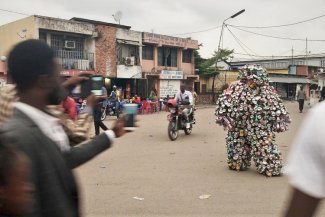Abhinav Agrawal (centre) sits with folk musicians as he sets up his mobile studio in Jaisalmer, Rajasthan, India.
In 2011 when Abhinav Agrawal was studying architecture in the central Indian city of Bhopal, every weekend he would catch a random train to visit a different part of the country. Getting off at both teeming cities and remote, rural villages he would set off to explore each region’s folk music, inspired by his love for the sheer diversity of styles, sounds and instruments, and his training as a classical vocalist and tabla player.
Equipped with just a laptop, sound card and microphone, he would record the music of the artists he encountered and burn CDs for them, free of cost. “The musicians began calling me and telling me that they wanted more CDs because the ones I had given them had been bought by people,” says 28-year-old Agrawal. “I saw a sort of trend where instead of depending on the kindness of strangers, the musicians were now able to make money from their art.”
For Agrawal, the motivation behind this investment of time and money was an attempt to “preserve” his “childhood memories.” Growing up in Bulandshahr, a small town in northern India, Agrawal learnt classical Indian music through the local music traditions of chaiti and kajari. But as urbanisation took over and nature began to disappear, so did the folk music associated with it. Sung in the towns and villages of Uttar Pradesh and Bihar, the lyrics of these musical styles are deeply connected to seasonal festivals and the natural landscape of the region. Chaiti, for example, is usually heard in the Hindu holy month of Chaith that falls between March and April, with songs that celebrate the birth and glory of Lord Rama. Meanwhile the lyrics of kajari describe the longing that wives feel during the monsoon season for their husbands who are away working in the cities.
This spurred Agrawal, after four years of informal recordings, to establish the Anahad Foundation in 2016 – a New Delhi-based NGO that empowers folk music communities across rural India by bringing production technology to their doorstep, recording their music, shooting videos and creating a digital presence for them – for free.
The website currently hosts over 1,000 artists and groups from the Indian states of Himachal Pradesh, Jharkhand, Karnataka, Punjab and Rajasthan that visitors can search by region, community (tribe), instrument and style.
For generations, India’s folk musicians have made what is often a precarious living travelling from village to village and city to city performing at weddings, festivals and other live events. Agrawal tells Equal Times that it takes over 25,000 Indian rupees (US$340) for folk musicians to record just one song in a professional studio along with the additional logistical expenses associated with travelling to the nearest city. Most folk musicians can’t bear that cost, but in today’s world, they can’t earn a decent living without recorded music and an online presence either. According to information published on the Anahad website, 70 per cent of India’s musicians fall under the category of ‘folk music’ but they earn just 2 per cent of industry revenues, thanks to the informal nature of their work.
The Covid-19 pandemic has shaken their already fragile world, with opportunities for live performances becoming ever more limited as India battles to contain one of the highest coronavirus death tolls in the world. Artists have struggled to put food on the table and some have even resorted to menial labour to make ends meet. This makes the work of Anahad Foundation even more crucial.
Studio in a rucksack
Anahad engages with folk musicians on the basis of those who will benefit most from the help (due to social or economic disadvantages) and those who Agrawal thinks the wider world would benefit most from learning about (because they play a rare instrument or come from one of India’s minority tribes). While initially Agrawal would contact these musicians himself, as the reputation and community of Anahad grew, artists now initiate contact.
Anahad records four songs and two high-quality, high-resolution videos for each group, as well as creating a microsite with details on how interested parties can contact the musicians directly, professional photos and biographies for each artist. The musicians are also offered courses on how to monetise their music via copyright and distribution, while young and tech-savvy leaders from the folk music community are trained in the intricacies of artist management: how to effectively market musicians, curate playlists for live performances, set fee structures and negotiate payments from clients. But the most powerful tool that allows Anahad to bring music production to remote villages across India is the ‘Backpack Studio’: a unique portable studio designed by Latin Grammy-winning sound engineer Gael Hedding. This high-quality wireless recorder with 12 mics can record without charge for three days – a must for Indian villages where electricity is both scarce and sporadic.
One of the most remarkable aspects of the Foundation’s work is that it does not charge the musicians for any of its services – nor does it pay any of the musicians directly.
Armed with a master’s in Global Entertainment and Music Business from Berklee Valencia in Spain, Agrawal has created a social enterprise where the money earned by one group is used directly to fund another. The monetization of Anahad’s recordings usually occurs via the royalties earned when the songs Anahad records are played on streaming services like YouTube and Spotify, or when the music is licensed for use in adverts, films and documentaries. “We don’t pay artists to record because then they would take the free digital portfolio for granted,” explains Agrawal. “We want them to see this as an investment of their time. Any royalties earned go towards helping other artists and creating new portfolios.”
For 42-year-old Kasam Khan, a folk artist from Phaloudi in Rajasthan, recording the music of his seven member-band with Anahad in 2017 helped develop his own music career. “The quality of Anahad’s videos are really good,” says Khan, a seasoned vocalist and harmonium player who has been performing for the past 16 years. “I got a lot of work because of them.” Khan credits booking several shows in Mumbai and Delhi as a consequence of curators seeing his work online. He also says that he has just recorded a song with the renowned Indian music composer and singer Ankur Tiwari and is also in conversation with producers to work on a Bollywood film next year. “A good voice is such a treasure,” says Khan. “But it needs to be recorded to be known.”
Challenges and future plans
Over the years the Foundation has faced many challenges. “Ninety percent of folk artists we meet have never done a recording,” says Agrawal. “They don’t know the benefits of recording and it takes a lot of effort to convince them.” Shuchi Roy, Anahad’s managing director and an intellectual property lawyer, finds that folk artists often get nervous when she explains the legalities of copyrighting their music to them. “Till date I have not met a folk artist that knows what a copyright is or has applied for one,” says Roy. “Folk music lies in the public domain so no one actually owns it. Big names in the [Indian] music industry often use folk music for free.”
Roy also mentors folk artists on how to navigate legal contracts – including using voice notes as documentation when artists don’t know how to write or type. “In the past few years, I’ve received many contracts from artists associated with Anahad,” says Roy. “They want me to review them before they sign it or help them re-negotiate payment terms. You don’t find folk artists doing this often.”
Procuring funding to support Anahad’s vision has not been easy. Being a charitable organisation means that for-profit business models have not been possible to replicate.
And with the Indian government’s historically low levels of investment in art and culture, Anahad is heavily reliant on corporate social responsibility budgets and philanthropic funding. Agrawal says most corporates prefer to invest in initiatives related to education, sanitisation and poverty-reduction. “Even those [companies] that support culture are usually looking at preserving something tangible, like monuments,” says Agrawal. “Folk music is intangible.”
Despite these hurdles Anahad has raised over US$400,000 from investors such as Infosys Group, Google and the Harish & Bina Shah Foundation, which has allowed the NGO to invest in thousands of artists, many of whom have performed all over the globe as a result of gaining more visibility. Over the course of the last eight months, due to the pandemic Anahad’s recordings have been put on hold. And yet Agrawal feels that the importance of their work has only grown. “The artists that have already recorded with us are reliant on our digital portfolio for their work,” he says. “Folk musicians are also connecting with us more actively than before to record and redesign their music.”
At present Agrawal is working on two projects with Anahad. The first is a skill development workshop, which he hopes will breathe new life into folk music. In these sessions, a folk group will be mentored by a renowned songwriter in the music industry to write new compositions in their own style. The other initiative is a mobile app that will allow folk artists to see how their songs have performed in the public domain and to bank royalties. According to Agrawal, the app which is due for release in April 2021, fills a crucial gap in the market: the lack of solutions for marketing and distributing folk music in the mainstream. “No music company is willing to sign up folk artists as they feel that their music is traditional and as a consequence does not have much intellectual value,” he says. “That is why we [Anahad] are creating our own distribution channel through the app.”
But Agrawal says that Anahad alone cannot keep Indian folk music alive. He hopes that government bodies and other organisations can develop innovative solutions to help folk artists create sustainable livelihoods, including museums and festivals of folk music. In the meantime, he takes great satisfaction in knowing that his Foundation’s work is playing an important role in keeping India’s rich folk traditions alive. “All the teachers I learnt folk music from had one dream: that someday their songs would be recorded in a studio,” says Agrawal. “They believed that if they had their own albums then they would get more respect – that they could become immortal through their music.” Today, he is helping many talented musicians achieve that immortality. “Whenever we record a folk music group and the vocalist hears his voice recording they start crying,” says Agrawal. “The singer can almost never believe that their voice can sound so good.”













